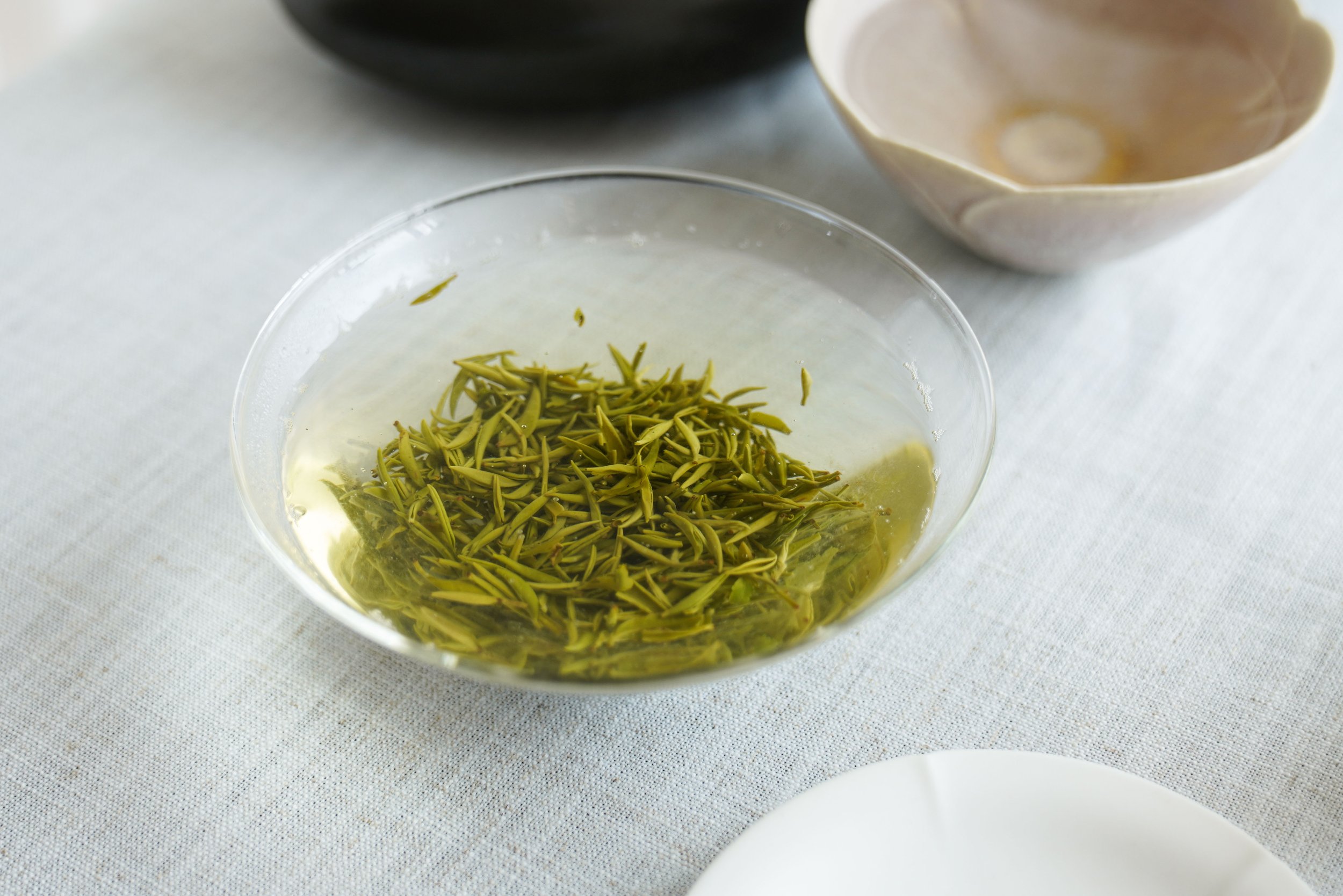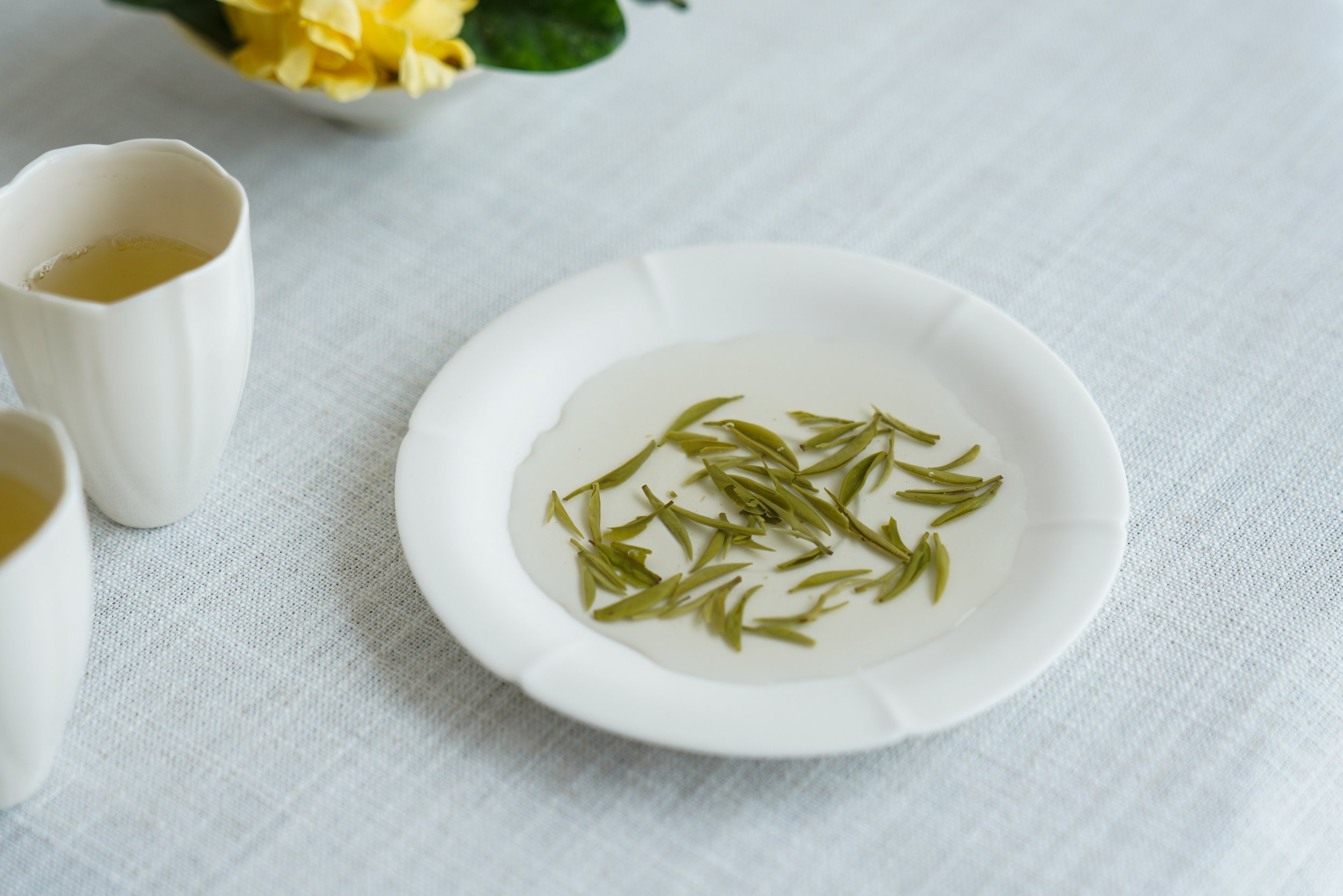2024 Pre-Ming Gou Gu Nao Green Tea












2024 Pre-Ming Gou Gu Nao Green Tea
After investing a considerable amount of time in sourcing, tasting, testing, and traveling to explore new green teas, we have finally made our second selection for 2024: an underestimated green tea, Gou Gu Nao, originating from Suichuan, Jiangxi, China. This tea is not well-known even in China, and the best part is that because it's not well-known, the price is very reasonable for its exceptional performance.
Gou Gu Nao tea is one of Jiangxi's cherished local teas, renowned for its production in Tanghu Town, Suichuan County, nestled in the southern foothills of the Luoxiao Mountains. The mountain, resembling a dog's head and named "Gou Gu Nao," lends its name to the tea cultivated there. In contrast to Dragon Well green teas, which are flat and relatively large, the tea leaves grown in this region are smaller and thinner, notable for their sweetness and refreshing aftertaste. Due to the tiny size of these leaves, our skillful tea farmers put a lot of care into handpicking and meticulous processing.
Gou Gu Nao tea has been made since the late Ming Dynasty, with a history of over 300 years. The tea leaves are tender and uniform, with a slightly green color covered by a layer of soft white fuzz, contributing to the pleasant sweetness and rich flavor. The tea liquid appears clear and golden, with a refreshing, aromatic, and pleasantly sweet taste that lingers for a very long time.
We have carefully selected three different grades for you to compare, each emphasizing slightly different experiences:
A - Special Grade: This grade has the tenderest tea buds and leaves and is harvested and processed earliest, on March 19th. The Special Grade is the sweetest, thanks to the tender tea buds and the alternating cooling early spring climate. It greets you with a delicate and sweet aroma once you open the package. It's a cooling type of sweetness, like spring water, rich in minerals. The astringency is very pleasant and lingers in your mouth for hours, keeping you cool on a hot summer day.
B - Premium Delicacy: This is the most balanced and delicate Gou Gu Nao we can find. It may not be as sweet as the Special Grade, but it has the perfect combination of sweetness, freshness, clarity, and a cooling aftertaste. The tea leaves were picked and processed on March 28th. It's a perfect premium option for an experienced green tea lover.
C - Bitter Boost: This is probably the most bitter one among these three. The tea leaves were picked and processed on March 28th. It has a strong taste and flavor, perfect for a busy day when you are craving a bold and strong bitter green tea. It has all the Gou Gu Nao features, with quick huigan (astringency comes fairly quickly). This option is perfect for hot summer days when you are busy but don’t want to sacrifice quality.
Overall, whether you are a green tea lover or not, we highly encourage you to try our Gou Gu Nao offerings. As picky green tea lovers ourselves, we only offer teas that truly speak to us. It's worth trying out new teas!
Suggested Brewing:
Brew with a Bowl and Spoon:
Tea to Water Ratio: Use 4 grams of tea leaves in a 240 ml bowl (1:60 ratio).
Water Temperature: Use water at 175°F (80°C).
Steeping Time: Steep for 30 seconds to 2 minutes, depending on your taste preference.
Steps:
Heat the Water: Bring water to 212°F (100°C).
Preheat the Bowl: Fill up your bowl with 70% of hot water, swirl it around, and then discard. This helps maintain the water temperature during brewing. The heat remaining in the bowl helps release the fragrance of your green tea.
Add Tea Leaves: Place 4 grams of tea leaves into the 240 ml bowl. (The temperature of your water will go down in the meantime.)
Steep: Pour hot water at 175°F (80°C) over the wall of your tea bowl and let the tea leaves steep for 30 seconds to 2 minutes. Use a spoon to scoop the tea liquid into your teacups.
Drink and Refill: Drink from the teacups. When the water level in the bowl gets low (about 1/3 of the tea liquid in the bowl), add more water at 175°F (80°C) or slightly higher, and repeat. You can continue to refill the bowl multiple times, enjoying the evolving flavor with each infusion.
Brew with a Tall Glass Cup (Grandpa Style):
Tea to Water Ratio: Use 4 grams of tea leaves in a 240 ml glass cup (1:60 ratio).
Water Temperature: Use water at 175°F (80°C).
Steeping Time: Steep for 30 seconds to 2 minutes, depending on your taste preference.
Steps:
Heat the Water: Bring water to 212°F (100°C).
Preheat the Glass: Pour a little hot water into the glass, swirl it around, and then discard. This helps maintain the water temperature during brewing.
Add Tea Leaves: Place 4 grams of tea leaves into the 240 ml glass cup. (The temperature of your water will go down in the meantime.)
Steep: Pour hot water at 175°F (80°C) over the tea leaves and let them steep for 30 seconds to 2 minutes. Taste the tea after 30 seconds and decide if you need to steep it longer.
Drink and Refill: Drink directly from the glass. When the water level gets low (about 1/3 of the tea liquid in the glass), add more water at 175°F (80°C) or slightly higher, and repeat. You can continue to refill the glass multiple times, enjoying the evolving flavor with each infusion.
How Should I Store My Green Teas?
Storing tea in a home setting is quite simple. Here are some key guidelines to follow:
Avoid Humidity: Keep your tea in a dry place to prevent it from absorbing moisture, which can degrade its quality.
Avoid High Temperatures: Store tea in a cool environment. High temperatures can cause the tea to lose its flavor and aroma.
Avoid Direct Sunlight: Exposure to sunlight can degrade the quality of tea leaves, so keep your tea in a dark place.
Avoid Oxygen Exposure: This is especially important for green teas, which undergo minimal processing. Store tea in airtight containers to limit its exposure to air.
Avoid Exposure to Strong Odors: Tea leaves can easily absorb surrounding odors, which can alter their taste.
We don’t recommend storing tea in your refrigerator, as the humidity can affect the tea, and tea leaves can easily absorb surrounding odors. Instead, store your tea in a cool, dry and airy place such as a shelf or cupboard.
If you cook frequently, avoid storing tea in the kitchen, as it might absorb food odors. A living room, furnished basement, or any cool, airy place is more suitable.
